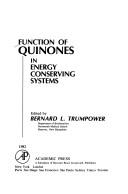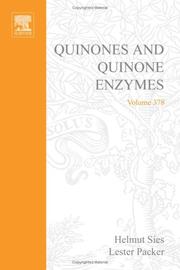| Listing 1 - 6 of 6 |
Sort by
|

ISBN: 012701280X 0323144683 1299364268 9780127012803 Year: 1982 Publisher: New York Academic Press
Abstract | Keywords | Export | Availability | Bookmark
 Loading...
Loading...Choose an application
- Reference Manager
- EndNote
- RefWorks (Direct export to RefWorks)
Ubiquinones --- Energy metabolism --- Physiological effect --- Energy metabolism. --- Bioenergetics --- Metabolism --- Microbial respiration --- Coenzyme Q --- Coenzyme Q10 --- Dimethoxymethylbenzoquinone --- Coenzymes --- Isopentenoids --- Quinone --- Physiological effect. --- Ubiquinones - Physiological effect
Book
Year: 2003 Publisher: Rockville, MD U.S. Dept. of Health and Human Services, Public Health Service, Agency for Healthcare Research and Quality
Abstract | Keywords | Export | Availability | Bookmark
 Loading...
Loading...Choose an application
- Reference Manager
- EndNote
- RefWorks (Direct export to RefWorks)
Cardiovascular system --- Antioxidants --- Vitamin C --- Vitamin E --- Ubiquinones --- Cardiovascular Diseases --- Review Literature. --- Treatment Outcome. --- Diseases --- Diet therapy. --- Chemoprevention. --- Therapeutic use. --- therapeutic use. --- prevention & control. --- therapy. --- Review Literature as Topic
Book
Year: 2003 Publisher: Rockville, MD U.S. Dept. of Health and Human Services, Public Health Service, Agency for Healthcare Research and Quality
Abstract | Keywords | Export | Availability | Bookmark
 Loading...
Loading...Choose an application
- Reference Manager
- EndNote
- RefWorks (Direct export to RefWorks)
Cardiovascular system --- Cardiovascular system --- Antioxidants --- Vitamin C --- Vitamin E --- Ubiquinones --- Antioxidants --- Cardiovascular Diseases --- Cardiovascular Diseases --- Review Literature as Topic --- Treatment Outcome. --- Diseases --- Diet therapy. --- Diseases --- Chemoprevention. --- Therapeutic use. --- Therapeutic use. --- Therapeutic use. --- Therapeutic use. --- therapeutic use. --- prevention & control. --- therapy.

ISSN: 00766879 ISBN: 0121827828 0121827860 9786611011499 1281011495 0080497209 9786611011451 1281011452 0080497160 9780121827861 9780121827823 Year: 2004 Volume: 378-382 Publisher: Burlington : Elsevier Science,
Abstract | Keywords | Export | Availability | Bookmark
 Loading...
Loading...Choose an application
- Reference Manager
- EndNote
- RefWorks (Direct export to RefWorks)
Quinones are members of a class of aromatic compounds with two oxygen atoms bonded to the ring as carbonyl groups. This volume covers more clinical aspects of quinines, such as anticancer properties, as well as their role in nutrition and in age-related diseases.*Mitochondrial Ubiquinone and Reductases*Anticancer Quinones and Quinone Oxido-Reductases*Quininone Reductases: Chemoprevention, Nutrition*Quinones and Age-Related Diseases
Enzymes -- Analysis. --- Enzymes. --- Glutathione. --- Quinone. --- Quinoproteins. --- Ubiquinones. --- Human Anatomy & Physiology --- Health & Biological Sciences --- Animal Biochemistry --- Amine Oxidoreductases. --- Antineoplastic agents. --- Gene Expression Regulation. --- Paracrine Communication. --- Quinone Reductases. --- Quinones. --- Ubiquinone. --- Xenobiotics. --- Ubiquinone --- Quinones --- Enzymes --- Organic Chemicals --- Enzymes and Coenzymes --- Coenzymes --- Benzoquinones --- Chemicals and Drugs --- Cofactors, Enzyme --- Enzyme Cofactors --- Coenzymes and Enzymes --- Chemicals, Organic --- Biocatalysts --- Coenzyme Q --- 2,5-Cyclohexadiene-1,4-Diones --- o-Benzoquinones --- p-Benzoquinones --- 1,2-Benzoquinones --- 1,4-Benzoquinones --- Benzodiones --- Cyclohexenes --- Molecular Mechanisms of Pharmacological Action --- Coenzyme --- Enzyme Cofactor --- Cofactor, Enzyme --- Organic Chemical --- Chemical, Organic --- Biocatalyst --- Enzyme
Book
ISBN: 9401783349 9400741375 9400741383 9786613697837 1280787449 Year: 2012 Publisher: Dordrecht : Springer Netherlands : Imprint: Springer,
Abstract | Keywords | Export | Availability | Bookmark
 Loading...
Loading...Choose an application
- Reference Manager
- EndNote
- RefWorks (Direct export to RefWorks)
Complex I (NADH:ubiquinone oxidoreductase) is the first and largest enzyme of the respiratory chain in mitochondria and plays a central role in cellular energy production. Complex I dysfunction has been implicated in many human neurodegenerative diseases, including Parkinson’s. Mutations in complex I subunits are among the most common human genetic disorders known. Until recently, in the absence of structural information, complex I was the least understood enzyme of the respiratory chain. The mechanism by which it couples electron transfer between NADH and quinone to the translocation of protons across the membrane was a complete enigma. Recent years have been marked by spectacular progress in the elucidation of complex I’s structure, finally allowing the interpretation of a wealth of data accumulated in about 50 years since the discovery of the enzyme. Understanding of the mechanism of this large molecular machine, involving long-range conformational changes, is beginning to emerge. This book is the first devoted entirely to complex I. It contains chapters written by leaders in the field, covering a wide range of topics from the structure of the complex, properties of its many redox centers, subunit composition, mutagenesis studies, evolution of the enzyme and on to the current understanding of the coupling mechanism and the molecular basis for human pathologies. Features: - Concise and authoritative review of current state-of-the-art in research on respiratory complex I - The first book entirely devoted to complex I, a central enzyme in bioenergetics - Recent breakthroughs in structure elucidation finally allow understanding of the mechanism - Mutations leading to common and severe human disorders are discussed.
Mitochondrial pathology. --- Oxidoreductases --- Dehydrogenases. --- NAD(P)H dehydrogenases. --- Ubiquinones. --- Coenzyme Q --- Coenzyme Q10 --- Dimethoxymethylbenzoquinone --- NADH, NADPH dehydrogenases --- NADH, NADPH oxidoreductases --- NAD(P)H oxidoreductases --- Medicine. --- Molecular biology. --- Biochemistry. --- Proteins. --- Cell membranes. --- Biomedicine. --- Biomedicine general. --- Biochemistry, general. --- Protein Structure. --- Membrane Biology. --- Molecular Medicine. --- Coenzymes --- Isopentenoids --- Quinone --- Dehydrogenases --- Biological chemistry --- Chemical composition of organisms --- Organisms --- Physiological chemistry --- Biology --- Chemistry --- Medical sciences --- Clinical sciences --- Medical profession --- Human biology --- Life sciences --- Pathology --- Physicians --- Cell surfaces --- Cytoplasmic membranes --- Plasma membranes --- Plasmalemma --- Membranes (Biology) --- Glycocalyces --- Composition --- Health Workforce --- Proteins . --- Cell membranes . --- Biomedicine, general. --- Molecular biochemistry --- Molecular biophysics --- Biochemistry --- Biophysics --- Biomolecules --- Systems biology --- Proteids --- Polypeptides --- Proteomics
Book
ISBN: 3030456420 3030456412 Year: 2020 Publisher: Cham : Springer International Publishing : Imprint: Springer,
Abstract | Keywords | Export | Availability | Bookmark
 Loading...
Loading...Choose an application
- Reference Manager
- EndNote
- RefWorks (Direct export to RefWorks)
This book offers a comprehensive exploration of research on the essential relationship of the coenzyme Q10 and the process of aging in living organisms. CoQ10 is an important factor in two main aspects of cell physiology: bioenergetics and antioxidant protection. While primary deficiency of CoQ10 is associated with severe and lethal disease, secondary deficiency can be associated with the progression of mitochondrial dysfunction linked to the lessening of biological activities during aging. The book is organized in four sections. The first offers an overview of the function of CoQ10, highlighting the two main functions of CoQ10 in cells: its essential role as electron transport chain member in mitochondria, and the protection of cell membranes against oxidation as one of the main endogenous-synthesized antioxidants. The second section covers research on Coenzyme 10. Topics include studies involving invertebrate models, mammal studies and the influence of CoQ on longevity. Also covered is research involving the role of CoQ in senescence-accelerated mice. Section three examines the effects of reduced CoQ in human aging, as evident in mitochondrial dysfunction, metabolic syndrome, neurodegenerative disorders, immunosenescence and fertility and reproduction. The final section, Prolongevity effectors and Coenzyme Q, explores research into slowing or stopping the aging process. Coverage includes strategies including calorie restriction, and modulation of CoQ10 levels by induction of synthesis or by supplementation. Coenzyme Q in Aging benefits a broad readership of researchers, clinicians, educators and students interested in the biochemical and physiological effects of coenzyme Q and the importance of this molecule in aging process.
Medicine. --- Cell biology. --- Internal medicine. --- Biochemistry. --- Physiology. --- Biomedicine, general. --- Cell Biology. --- Internal Medicine. --- Biochemistry, general. --- Animal physiology --- Animals --- Biology --- Anatomy --- Biological chemistry --- Chemical composition of organisms --- Organisms --- Physiological chemistry --- Chemistry --- Medical sciences --- Medicine, Internal --- Medicine --- Cell biology --- Cellular biology --- Cells --- Cytologists --- Health Workforce --- Physiology --- Composition --- Ubiquinones --- Physiological effect. --- Coenzyme Q --- Coenzyme Q10 --- Dimethoxymethylbenzoquinone --- Coenzymes --- Isopentenoids --- Quinone --- Envelliment --- Coenzims --- Citologia --- Biologia cel·lular --- Biologia --- Citogenètica --- Citoquímica --- Migració cel·lular --- Cèl·lules --- Cèl·lules animals --- Ultraestructura (Biologia) --- Enzims --- NAD (Coenzim) --- Senectut --- Biologia del desenvolupament --- Persones de mitjana edat --- Persones grans --- Gerontologia --- Longevitat --- Envelliment cerebral --- Factors d'edat en les malalties
| Listing 1 - 6 of 6 |
Sort by
|

 Search
Search Feedback
Feedback About
About Help
Help News
News